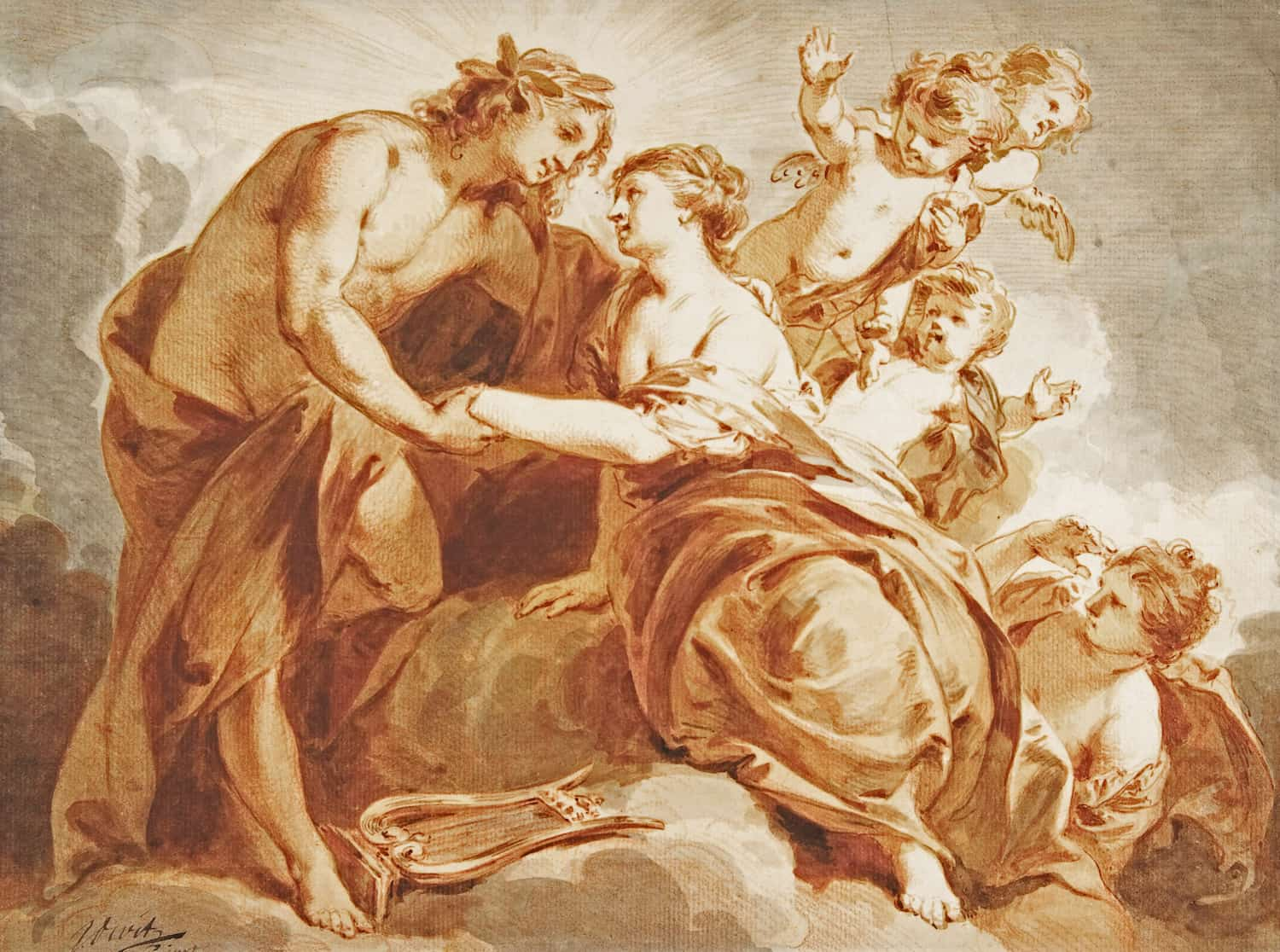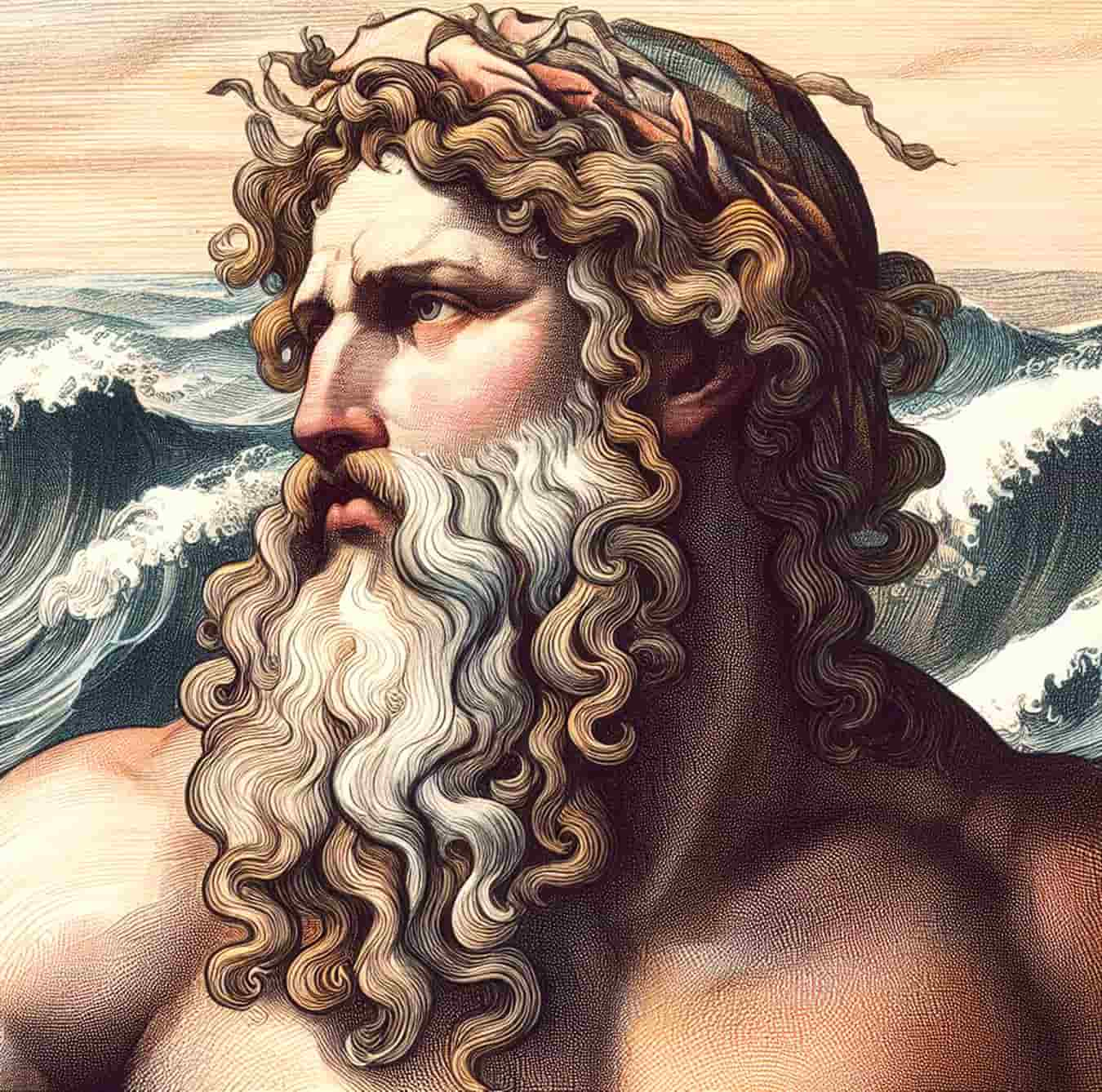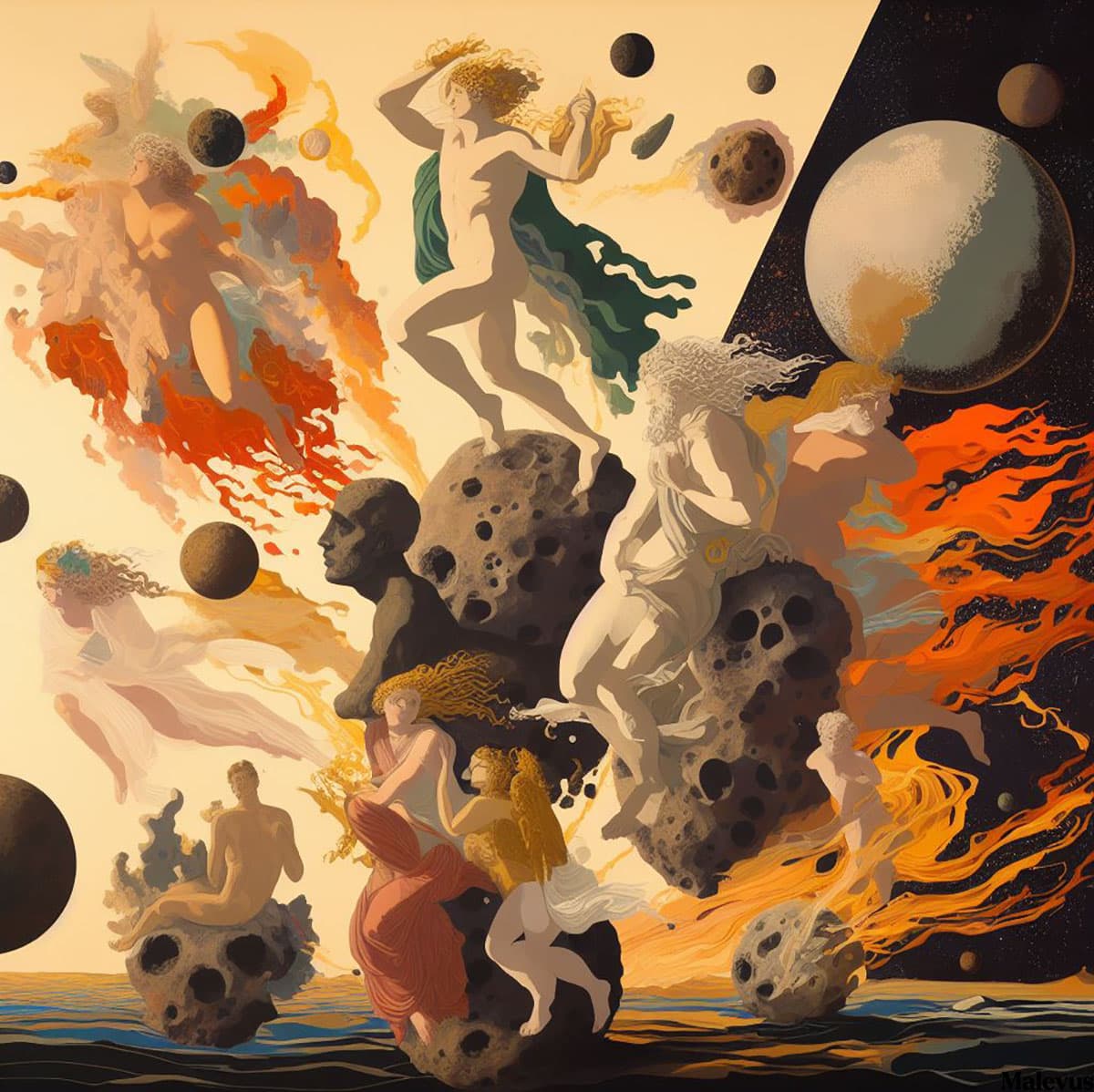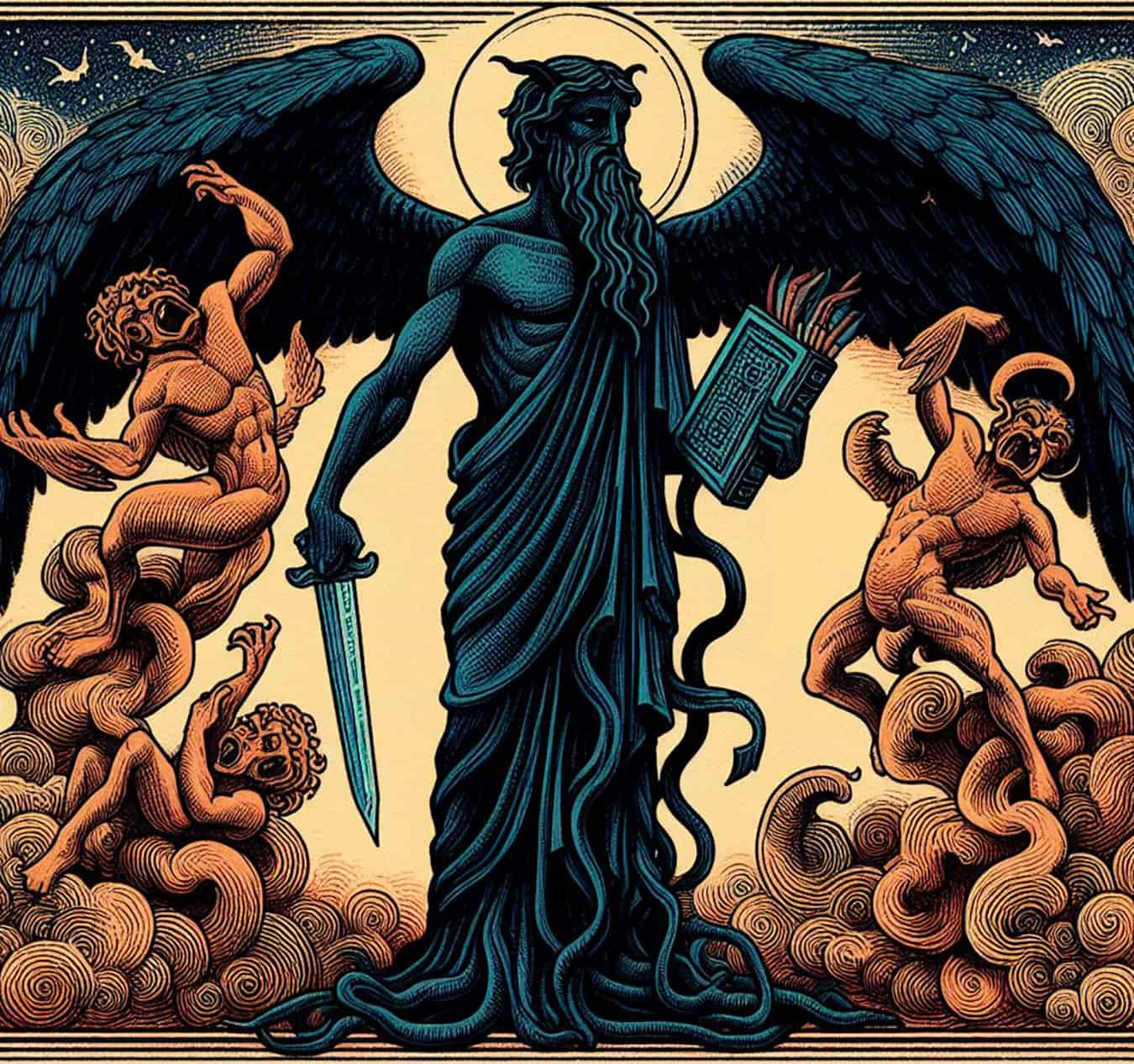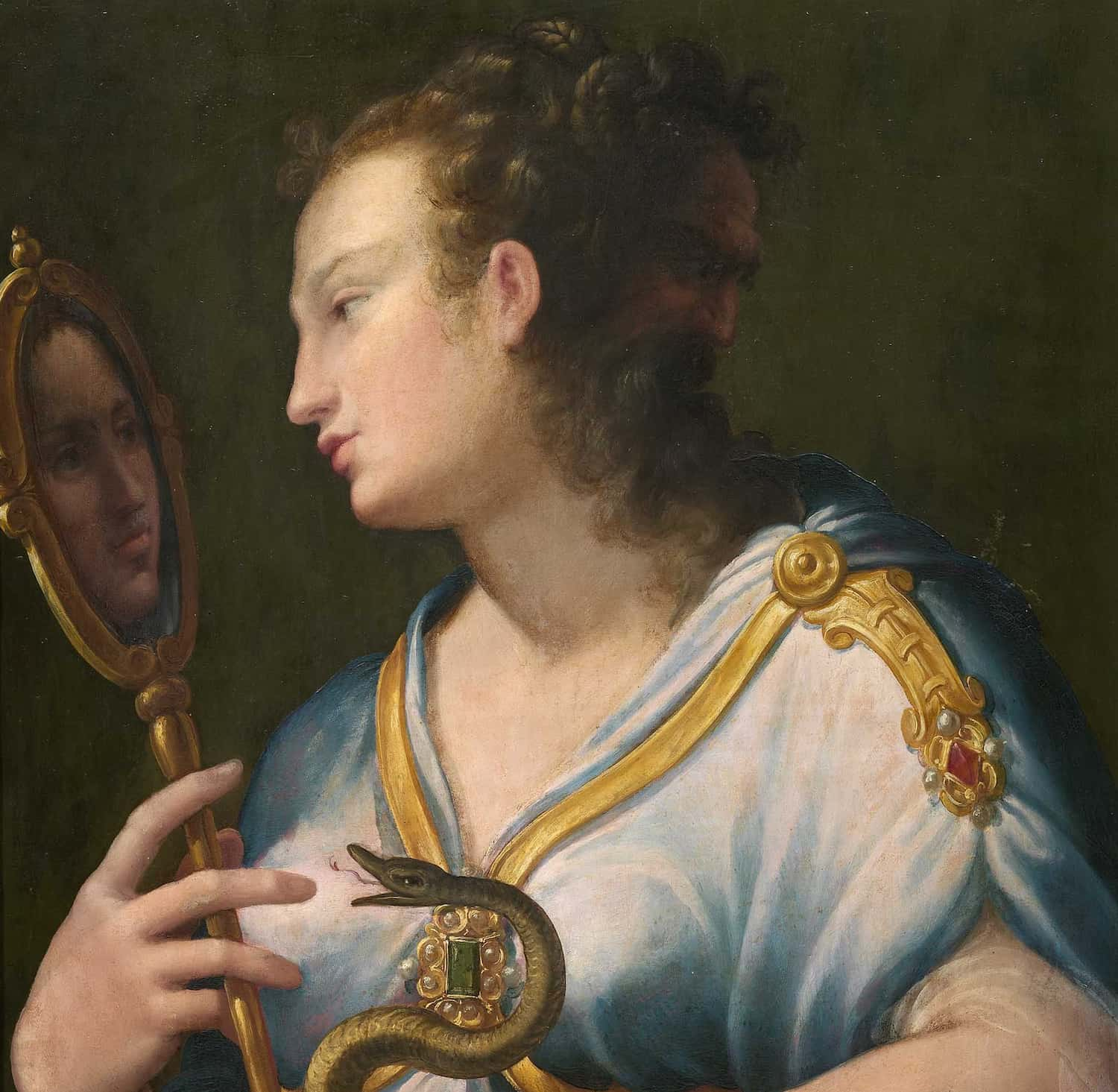In Greek mythology, the Nereids are marine nymphs, the daughters of Nereus and Doris. According to tradition, the Nereids were particularly proud of their beauty. When Cassiopeia, the wife of King Cepheus of the Cepheans, boasted that she was more beautiful than the Nereids, they became angry and asked Poseidon to punish her. Indeed, Cepheus was forced to chain his daughter Andromeda to a sea rock to be torn apart by a sea monster. However, Perseus intervened and saved Andromeda.
Etymology
Nereids comes from the Latin word of the same meaning, Nereides (plural of Nereis), itself derived from the ancient Greek Νηρῇδες / Nērêides, the plural form of Νηρῇς (Nērêis) (or Νηρηΐδες / Nērēḯdes, the plural form of Νηρηΐς (Nērēḯs)). This term is derived from Nereus (Νηρεύς (Nēreús)), the father of the Nereids; the latter may be connected to the verb νέω (néō), meaning “to swim.”
Mythology
The Nereids are marine nymphs, daughters of the sea god Nereus and the Oceanid Doris. They number fifty and form the retinue of Poseidon; particularly associated with the Aegean Sea, they are often depicted riding sea monsters, symbolize the movement of the sea and live in underwater palaces. They are portrayed as beautiful young girls with hair interwoven with pearls, riding on dolphins or seahorses, and holding in their hands either a trident, a crown, a victory, or a branch of coral. Sometimes, they are depicted as sirens, half-women, and half-fish, which is why they are often present with the Tritons in ancient paintings and sculptures.

Some Nereids are more well-known than others, such as Amphitrite, the wife of Poseidon, Thetis, the mother of Achilles, Galatea, loved by the Cyclops Polyphemus, or Psamathe, the mother of Phocus with Aeacus.
In Homer’s Iliad, when Thetis mourns in sympathy for Achilles’ grief over the death of Patroclus, her sisters appear. Opis is mentioned in Virgil’s Aeneid; she is called upon by the goddess Diana to avenge the death of the warrior Camilla, killed by Arruns. Armed by Diana, Opis pierces Arruns with an arrow.
The Nereids take pride in their beauty. When the queen of Ethiopia, Cassiopeia, claims that her daughter Andromeda is more beautiful than the Nereids, they demand that Poseidon avenge them. He sends the sea dragon Cetus to ravage the country’s shores. Panicked, Cepheus seeks advice from the Oracle of Ammon in Libya, which tells him that the only way to save his kingdom is to sacrifice his daughter Andromeda to the monster.
Antique Catalogs

Four ancient works catalog various Nereids. The names vary from one list to another, resulting in nearly a hundred distinct Nereids:
In “Apollodorus,” in the Library (Book I, Chapter 2, Paragraph 7), 45 Nereids are mentioned:
“From Nereus and Doris, daughter of Ocean, were born the Nereids, whose names are as follows: Cymothoe, Speio, Glauconomy, Nausitoe, Alie, Erato, Sao, Amphitrite, Eunice, Thetis, Eulimene, Agavé, Eudore, Doto, Pherusea, Galatea, Cosh, Protomedusa, Hippothoe, Lysianasse, Cymo, Éioné, Alimede, Plexaurus, Eucrante, Proto, Calypso, Panope, Cranto, Neomeris, Hipponoe, Ianira, Polynoe, Autonoe, Melite, Dione, Neaseus, Dero, Evagore, Psamathea, Eumolpus, Ione, Dynamene, Keto and Limnorea.”
Hesiod, in the Theogony (verses 240 to 264), lists 53:
“And from Nereus was born the lovely race of the goddesses, in the barren sea, of fair-haired Dôris, daughter of the endless river Ocean: Proto, Eukrates, Sao, Amphitrite, Eudorus, Thetis, Galena, Glauce, Kymothoe, the swift Speo, the laughing Thalia, the graceful Melite, Eulimene, Agave, Pasithea, Erato, Rose-armed Eunice, Doto, Proto, Pherouse, Dynamenes, Nesea, Cohosh, Protomedia, Doris, Panope, the beautiful Galatea, the charming Hippothoë, the pink-armed Hipponoë, Cymodoce who easily soothes the waves of the black sea and the breath of the sacred winds, with Cymatolegra and with Amphitrite adorned with beautiful feet; and Cymo, Eione, richly crowned Halimedus, the joyful Glauconomy, Pontoporia, Leagoras, Evagore, Laomedia, Polynomia, Autonoe, Lysianassa, Evarne endowed with an amiable nature and perfect form, Psamathea with a beautiful body, the divine Menippe, Neso, Eupompeius, Themistus, Pronoe, Nemertes who had the soul of her immortal father. Thus from the blameless Nereus were born fifty daughters skilled in irreproachable work.”
Homer, in the Iliad (Book XVIII, verses 38 and following), counts 34:
“And around the Goddess were gathered all the Nereids who are at the bottom of the sea: Glauce, Thalia, Cymodoke, Nesea, Speio, Thoe, Bull-eyed Halia, Cymothoe, Alcaeus, Limnoria, Melite, Iaera, Amphithoe, Agavé, Lotto, Proto, Pherouse, Dynamene, Dexamenes and Amphinome, Callianassa, Doris, Panope, the illustrious Galatea, Nemertes, Apseudes, Callianira, Clymenes, Ianira, Ianassa, Mera, Oreithye, Amathea of the beautiful hair, the other Nereids who are in the deep sea.”
Hyginus, in the preface of the Fabulae, lists 48:
“Of Nereus and Doris, fifty Nereids, Glauce, Thalia, Cymodoce, Born, Spéio, Thoe, Cymothoe, Actaea, Limnoria, Melita, Iaera, Amphithoe, Agavé, Doto, Proto, Pherusea, Dymanene, Dexamene, Amphinome, Callianassa, Panis, Galatea, Nemertes, Apseudes, Clymenes, Ianira [Panope], Ianassa, Mera, Orithyia, Amathea, Drymo, Xantho, Ligaeus, Phyllodoce, Cydippus, Lycorias, Clio, Beroe, Ephyre, Opis Asia, Deiope, Arethusa [Clymene], Creneis, Eurydice, Leuchothé.”
The following table summarizes the mentions made by these four authors. The Greek name and its transcription are also indicated, except when present only in Hyginus (a Latin-language writer).
| Nereid | Greek Name | Transcription | Apollodorus | Hesiod | Homer | Hyginus |
|---|---|---|---|---|---|---|
| Cohosh | Ἀκταίη | Aktaíē | ||||
| Agave | Ἀγαυή | Agauḗ | ||||
| Amathea | Ἀμάθεια | Amátheia | ||||
| Amphinomé | Ἀμφινόμη | Amphinómē | ||||
| Amphithoe | Ἀμφιθόη | Amphithóē | ||||
| Amphitrite | Ἀμφιτρίτη | Amphitrítē | ||||
| Apseudes | Ἀψευδής | Apseudḗs | ||||
| Arethusa | Ἀρέθουσα | Arethusa | ||||
| Asia | Ἀσία | Asía | ||||
| Autonomous | Αὐτονόη | Autonóē | ||||
| Béroé | Βερόη | Beróē | ||||
| Callianassa | Καλλιάνασσα | Kalliánassa | ||||
| Callianira | Καλλιάνειρα | Kalliáneira | ||||
| Calypso | Καλυψώ | Kalypsṓ | ||||
| Keto | Κητώ | Kētṓ | ||||
| Clio | Κλειώ | Kleiṓ | ||||
| Clymene | Κλυμένη | Klyménē | ||||
| Cranto | Κραντώ | Krantṓ | ||||
| Crenéis | ||||||
| Cydippus | Κυδίππη | Kydíppē | ||||
| Cymatolegium | Κυματολήγη | Kymatolḗgē | ||||
| Cymo | Κυμώ | Kymṓ | ||||
| Cymodoceae | Κυμοδόκη | Kymodókē | ||||
| Cymothoe | Κυμοθόη | Kymothóē | ||||
| Deiope | ||||||
| Déro | Δηρώ | Dērṓ | ||||
| Specimen | Δεξαμένη | Dexaménē | ||||
| Dione | Διώνη | Diṓnē | ||||
| Dory | Δωρίς | Dōrís | ||||
| Doto | Δωτώ | Dōtṓ | ||||
| Drymo | ||||||
| Dynamene | Δυναμένη | Dynaménē | ||||
| Éioné | Ἠιόνη | Ēiónē | ||||
| Ephyra | ||||||
| Érato | Ἐρατώ | Eratṓ | ||||
| Eucrante | Εὐκράντη | Eukrántē | ||||
| Eudore | Εὐδώρη | Eudṓrē | ||||
| Eulimene | Εὐλιμένη | Euliménē | ||||
| Eumolpus | Εὐμόλπη | Eumólpē | ||||
| Eunice | Εὐνίκη | Euníkē | ||||
| Eupomp | Εὐπόμπη | Eupómpē | ||||
| Eurydice | Εὐρυδίκη | Eurydíkē | ||||
| Evagoré | Εὐαγόρη | Euagórē | ||||
| Évarné | Εὐάρνη | Euárnē | ||||
| Galatea | Γαλάτεια | Galáteia | ||||
| Galena | Γαλήνη | Galḗnē | ||||
| Glaucé | Γλαύκη | Glaúkē | ||||
| Glauconoma | Γλαυκονόμη | Glaukonómē | ||||
| Halié | Ἁλίη | Halíē | ||||
| Halimeda | Ἁλιμήδη | Halimḗdē | ||||
| Hipponoe | Ἱππονόη | Hipponóē | ||||
| Hippothoe | Ἱπποθόη | Hippothóē | ||||
| Iaéra | Ἴαιρα | Íaira | ||||
| Ianassa | Ἰάνασσα | Iánassa | ||||
| Ianira | Ἰάνειρα | Iáneira | ||||
| Ioné | Ἰόνη | Iónē | ||||
| Laomedy | Λαομέδεια | Laomedeia | ||||
| Leagoras | Ληαγόρη | Lēagórē | ||||
| Leucothoea | Λευκοθέα | Leukothea | ||||
| Ligie | Λιγεία | Ligeía | ||||
| Limnoria | Λιμνώρεια | Limnṓreia | ||||
| Lycorias | ||||||
| Lysianassa | Λυσιάνασσα | Lysiánassa | ||||
| Mera | Μαῖρα | Maîra | ||||
| Melity | Μελίτη | Melítē | ||||
| Menippe | Μενίππη | Meníppē | ||||
| Nausithoe | Ναυσιθόη | Nausithóē | ||||
| Nemertes | Νημερτής | Nēmertḗs | ||||
| Neomeris | Νεόμηρις | Neómēris | ||||
| Born | Νησαίη | Nēsaíē | ||||
| Neso | Νησώ | Nēsṓ | ||||
| Opis | ||||||
| Orithye | Ὠρείθυια | Ōreíthyia | ||||
| Panopae | Πανόπεια | Panópeia | ||||
| Geoduck clam | Πανόπη | Panópē | ||||
| Pasithea | Πασιθέη | Pasithéē | ||||
| Pheruse | Φέρουσα | Pherousa | ||||
| Phyllodoce | ||||||
| Pleuxaure | Πληξαύρη | Plēxaúrē | ||||
| Ploto | Πλωτώ | Plōtṓ | ||||
| Polynomial | Πολυνόμη | Polynómē | ||||
| Pontomeduse | Ποντομέδουσα | Pontomedousa | ||||
| Squirtoria | Ποντοπόρεια | Pontopóreia | ||||
| Poulunoe | Πουλυνόη | Poulynóē | ||||
| Pronoé | Προνόη | Pronóē | ||||
| Proto | Πρωτώ | Prōtṓ | ||||
| Protomediary | Πρωτομέδεια | Prōtomedeia | ||||
| Psamathea | Ψαμάθη | Psamáthē | ||||
| Sao | Σαώ | Saṓ | ||||
| Specio | Σπειώ | Speiṓ | ||||
| Thalia | Θάλεια | Tháleia | ||||
| Themisto | Θεμιστώ | Themistṓ | ||||
| Thetis | Θέτις | Thetis | ||||
| Thoe | Θόη | Thóē | ||||
| Xantho |
Other authors
Some Nereids not present in the four main catalogues can also be found:
- Neera, Neaera or Neera, possibly the mother of Absyrtus by Aetes.
- Pronoia, Foresight, wife of Prometheus, a Nereid or an Oceanid according to the authors, possibly confused with Pronoe.
- Iphianassa, one of the 50 Nereids according to Lucien.
The Nereids in Art
The Nereids in art, both in black-figure and red-figure pottery as well as in sculpture, hold the most notable position in the inspirations of epic and lyric poetry. They are depicted with modest form and attire, sometimes nude, playing with Erotes, and in performances alluding to the afterlife on the Isles of the Blessed.
Folklore
The Nereids persist even today in the beliefs of the Greeks with a slight alteration of the name as nymphs called “Neraides,” and they even have a celebration on March 15th. “Neraides” was the most ancient form of the name, as conveyed by Homer, Hesiod, and others. These two words, “neraida” and “Neraida,” trace back to the term “Nerti,” meaning “to sink.” The etymology of the name, according to which “neraida” comes from the word “nera,” also emphasizes their close connection to water. After all, the fairytale Neraides resemble water nymphs. Like nymphs, they live in mountains, forests, rivers, springs, fountains, caves, etc. throughout nature and are called by various names: anerades, aneragodes, neraisses, xeramenes, avragides, etc. They move in circular spaces (threshing floor, fountain, lake, spring), just as their movements in dance or spinning are circular.
They are beautiful, with long blonde hair, usually green eyes, and wearing white dresses with white scarves. They are only seen by those born on Saturdays and those who fast. Their leader is Lady Kalo, and they have many names, such as Astero, Ourania, Lampetia, Canela, Kalo, etc. They enjoy dancing and often snatch lyre players to play for them and dance. Usually, they come out at midnight, enter homes, and steal women’s clothes.
As women, they tempt men, enchant them, and then escape through a divided expression of their sexuality. Despite their supernatural origin, their activities are identified with traditional female roles: they care for the cleanliness of the body and generally love water. Neraides marry Neraides, have children, and, in some traditions, weave.
The Neraida represents the ideal and fearsome femininity, encompassing numerous female qualities: her representations refer to the symbolism of water, spinning, and household, bridal representations, desire, and death.
Confusion of the Sirens with the Nereids
The sirens originally were beings with the head of a woman and the body of birds who sang songs that lured sailors until they crashed their ships against the cliffs of the islands they inhabited, later being devoured by these beings. Even in the times of Apollonius of Rhodes, sirens were characterized in this form. In the Odyssey, its main protagonist, Odysseus, or Ulysses, has himself tied to the mast of his ship and forces the rest of the crew to plug their ears with wax so that he can listen to the sirens’ song without risking his life.
After the sirens lost a singing contest with the Muses, an event that caused them to lose their feathers, their inclusion in oral traditions did not reappear prominently, and later, in the 7th and 8th centuries, sirens were described in the Liber monstrorum de diversis generibus with fish tails rather than bird bodies. However, the tail was also not an element that was part of the original iconography of the Nereids, as seen in images of Thetis and Galatea, among many others, who were represented with legs, sometimes accompanied by fish or riding dolphins. It is possible that the tail was an iconographic element added due to the visual confusion in certain paintings where the legs of a Nereid on the back of a dolphin were not clearly distinguishable, leading to the confusion of the dolphin’s tail with the lower part of the Nereid’s body.
Writer Robert Graves suggests that the Nereids were a group of around 50 priestesses of the goddess Luna, called “seal women” because they dressed in seal skins and performed a ritual dance in Aegina and Magnesia as a prelude to the ceremony for selecting a sacred king. These Nereids also conducted magical rites to ensure a good catch for fishermen.
Modern Evocation
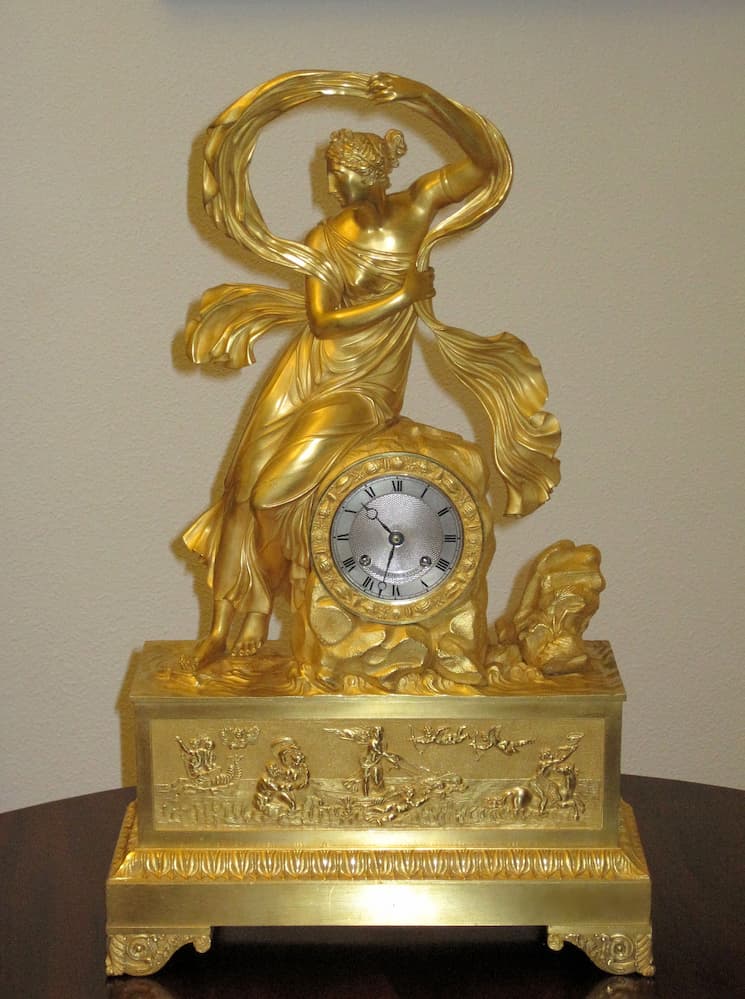
Zoology
The names of Nereus, Doris, and most Nereids are attributed to several marine animals (originally as genus names), such as:
- Annelids: Nereis, Amphinome, Amphitrite, Clymene, Dero, Eunice, Eupompe,
- Hipponoe, Neomeris, Pheruse, Phyllodoce, Polynoe, Psamathe, Spio, Xantho
- Cnidarians: Dynamene, Laomedie, Nausithoe, Plexaure, Thoe
- Crustaceans: Amphithoe, Apseudes, Autonoe, Cymodoce, Callianassa, Cymo, Dexamenae, Dynamene, Eucrate, Eurydice, Galatea, Galene, Halimede, Leucothea, Limnoria, Pontoporeia, Pronoe, Protomedea, Themisto, Thoe, Xantho
- Ctenophores: Beroe, Callianira, Cydippe, Deiope
- Bryozoans: Pheruse
- Nemertines: name of the phylum; several genus names are also derived from Nemertes
- Mollusks: Clio, Doris, Erato, Glauconome, Panope
Insects, especially butterflies, also derive their names from the Nereids:
- Coleoptera: Eumolpe
- Lepidoptera: Cymothoe, Melite, Pontoporeia
Botany
Several genera of algae are named after the Nereids:
- Red Algae: Dione, Galene
- Green Algae: Halimeda, Neomeris
As well as marine grasses:
- Cymodocea
Other plants also include:
- The genus Agave could derive its name from Agave.
- Ericaceae: Leucothea, Phyllodoce
Astronomy
Nebula
SNR 107.5-5.2, nicknamed the Nereid Nebula, a supernova remnant discovered in 2023, was named by its discoverers due to the wavy appearance of its nebulosities, resembling waves, and its location in the constellation Cassiopeia, coinciding with the story of Queen Cassiopeia, who offended the Nereids.
Moons
The natural satellites of Neptune are named after characters from Greco-Roman mythology associated with Poseidon/Neptune and the oceans. In particular, the irregular satellites are named after the Nereids:
- Galatea
- Halimede
- Laomedeia
- Nereid
- Neso
- Psamathe
- Sao
Several other moons are named after Nereids:
- Themisto, one of Jupiter’s moons
- Actaea, a moon of the trans-Neptunian object
Asteroids
- (188) Menippe is a main-belt asteroid named after the Nereid Menippe.
- (200) Dynamene is a main-belt asteroid named after the Nereid Dynamene.
- (35) Leukothea (international designation (35) Leukothea) is a main-belt asteroid named after the Nereid Leucothoe
- (427) Galene is a main-belt asteroid named after the Nereid Galene


